|
|
Obelisks in the Nubian Museum (5 objects)
| Present Site: | Al Fanadek, Aswan, Egypt N 24°04'47.0"(24.079718) E 32°53'22.1"(32.889479) |
| 1. | Pharaoh: | Ramses II (The 19th Dynasty, 13 Century BC) |
| Portion & Size: | Whole, About 2.5 meters high | |
| 2. | Pharaoh: | Ramses II (The 19th Dynasty, 13 Century BC) |
| Portion & Size: | Whole, About 2.7 meters high | |
| 3. | Pharaoh: | Amenhotep II (The 18th Dynasty, 15 Century BC) |
| Portion & Size: | Upper portion, About 1.1 meters high | |
| 4. | Pharaoh: | Thutmose IV (The 18th Dynasty, 15-14 Century BC) |
| Portion & Size: | Portion, About 1.2 meters high | |
| 5. | Pharaoh: | King Atlanersa (Kingdom of Kush, 7 Century BC) |
| Portion & Size: | Portion, About 2.8 meters high |
About The Site:
Five (5) obelisks exists in the Nubian Museum, officially named as the International Museum of Nubia, where is in Aswan, Upper Egypt.
The Nubian Museum is a modern museum, which was opened in 1997. When this museum was opened, many Nubian antiquities which was stored in Egyptian Museum (Cairo) were transported to this Nubian Museum. In this museum, the colections are exhibited according to the period classification, and many important objects are included. Also in this museum, the artifacts in the period of Ancient Roman territory, Coptic Period, Nubian related relics after Islamization are exhibited. The picture without flash light is allowed, but it may be difficult to take pictures due to poor lighting. Sine the museum is not so large, two hours or so are enough time for looking around all the collections including obelisks which are exhibited outdoor.
The well-known "Unfinished Obelisk" is close to this Nubian Museum, it would be better to visit there after visiting this museum. This is worth to see it because if it was finished (completed), this would be the largest obelisk in the world.
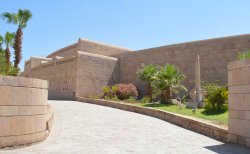 Entrance of the Museum Entrance of the MuseumSmall obelisk can be seen at right |
How To Get There:
For Aswan from Cairo, airplane, train (sleeping car), or bus are available.
In Aswan, no public transportation such as bus is not available, so the foreign tourists basically use a taxi.
The Nubian Museum is out of Aswan city area. If you stay at Sofitel Legend Old Cataract, a high-class hotel, which is located near to the museum, you can go there by walk. But most of the hotels are in Aswan city area, we should use a taxi. Long-time walking in summer, in May to September, is not recommended as it's very hot in Aswan.
When I visited here in summer 2014, the museum opened at 9:00 AM, and closed at 12 noon, due to very few tourists. So you should check the opeing hours of the museum in advance.
About The Obelisk:
In this museum, one obelisk is exhibited indoor, and four (4) obelisks are exhibited outdoor. Everything were discovered around Aswan region.
1. Obelisk of Ramses II
Two (2) obelisks (as a pair) were dedicated by Ramses II (Reigned 1278-1212 BC), to the inside of a small rock chapel which was south of Abu Simbel Temples. These two obelisks were probably transpoted and added to the collection of Egyptian Museum in Cairo, when the Abu Simbel Temples were relocated in 1964-1967 by UNESCO in order to prevent their being submerged during the building construction of the Aswan High Dam. When this Nubian Museum was opened in 1997, two obelisks were transported to this museum, and one was exhibited beside a passage to the entrance of the museum building. This is the one. And, another one was exhibited inside of the museum building (see next article below).
This obelisk itself is about 2.5 meter high, and is made by sand stone, according to the museum's description.
Baboons: The stone statues of four baboons are placed around the pedestal. When the obelisks were inside of a rock chapel, these four baboons were placed on the altar, not together with the obelisk. This is also assumed becase only one set of statues (four baboons) exist, but obelisks are two.
Baboon is a kind of Cercopithecidae (monkey) in Africa, and the people at that time believed baboon begins the dancing when the sun rises from east horizon in the morning.
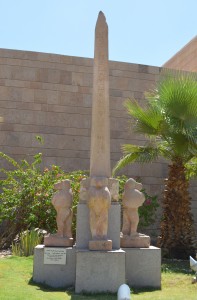
West side |
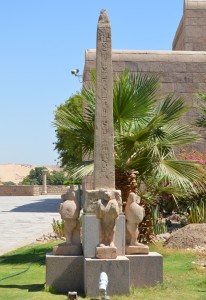
South side |
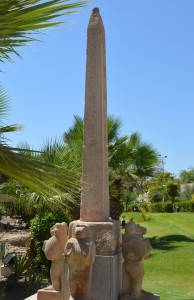
North side |
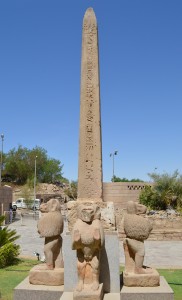
East side |
|||
August 7, 2014 by Hiroyuki Nagase (For high definition image, please click the picture) | ||||||
2. Obelisk of Ramses II (Exhibited indoor)
This is exhibited inside the Nubian Museum. And, this is one of the pair with the obelisk above mentioned 1. However, the hieroglyph is engraved on two sides only on this obelisk, against on the outdoor obelisk, engraved on four sides. On the measurement, this obelisk is about 2.7 meters high, which is slightly longer than the outdoor obelisk. Comparing the inscriptions of the two obelisks of the outdoors and the indoors, it is certain both were made by pair, because the contents of the descriptions, typeface and form are same. The reason why no inscription on two faces of this indoor obelisk is unknown. Since the style of Ancient Egypt prioritizes the symmetry, this pair obelisks are exceptional case.
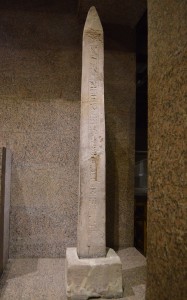 Front side |
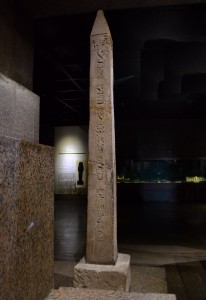 Left side |
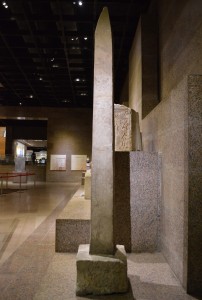 Right side |
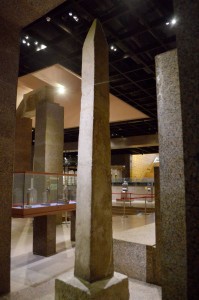 Right side & back side |
|||
August 7, 2014 by Hiroyuki Nagase (For high definition image, please click the picture) | ||||||
3. Obelisk of Amenhotep II (Upper portion)
This is one of pairs with the obelisk in Durham University, Norther England. This was found this was used for the building material of a house in Elephantine Island, front of Aswan Town. This Elephantine Island is the place where the capital town of the First Nome was placed in ancient Egypt. This obelisk was erected by Amenhotep II (New Kingdom The 18th Dynasty, Reigned 1453-1419 BC).
The size is about 1.1 meters high, which is about a upper half of the obelisk in Durham University.
The hieroglyph is engraved on one side only. With the direction of God Horus at the top of this obelisk, It's understood this obelisk was erected on the left side, and the obelisk in Durham University was erected on the right side, when this pairs were in front of the temple in Elephantine Island.
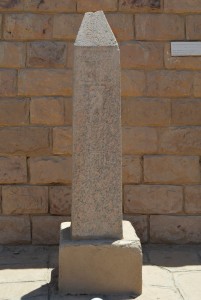 Front side |
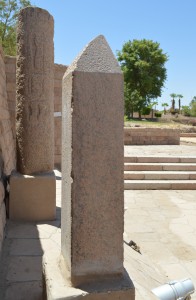 Left side |
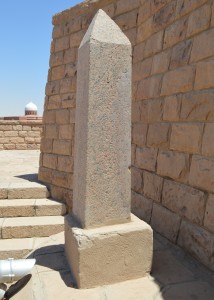 Right side |
||
August 7, 2014 by Hiroyuki Nagase (For high definition image, please click the picture) | ||||
4. Obelisk of Thutmose IV (Portion)
This is a small obelisk, the current size is about 1.2 meters high. Since the cartouche of birth name is at the upper side, it's assumed that the upper half of the obelisk is missing. Because the preservation state of the inscription is not good, the hieroglyph cannot be read through the picture, but according to the description of the Nubian Museum, it's determined as an obelisk of Thutmose IV (The 18th Dynasty, Reigned 1419-1386 BC). This was unearthed in Elephantine Island.
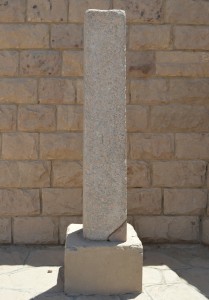 Front side |
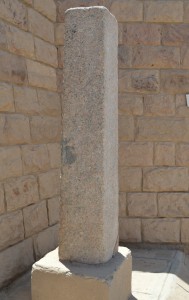 Left side |
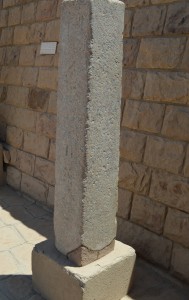 Right side |
||
August 7, 2014 by Hiroyuki Nagase (For high definition image, please click the picture) | ||||
5. Obelisk of King Atlanersa (Portion)
This obelisk, the upper portion is missing, and also the cylindroid shape with cutting off the four corners when this was used as the stone material for the church in later eras. So, as a whole, the preservation state is not good, and only a center portion of the hieroglyph remains. According to the description of the Nubian Museum, it was unearthed in Old Dongola, upper Nile, currently Sudanese territory.
Although no pharaoh's name is described by the Nubian Museum, but according to the list of Egyptian Museum (Cairo), "Lower part from obelisk of Atlanersa, re-used as column in a church". According to the wikipedia site, Atlanersa was a Nubian king who has ruled around 653 to 640 BC. King Atlanersa was a successor of King Tantamani, who was the last king of the 25th dynasty of the Kingdom of Kush which ruled the upper Nile region including current Sudan. Although the Assyrian Army often invated into Egypt (lower Nile) and Kush (upper Nile), but Old Dongola region was maintained because it's upstream (southern) region than the Third Caratact of the Nile.
On the website of Boston Museum, the picture of "Boat stand of King Atlanersa" is posted. King Atlanersa's coronation name and the birth name are engraved at left side of the inscription in that picture. I did confirm that the engraved name on the "Boat stand of King Atlanersa" corresponds to the remained king's name on the south side of this obelisk. Therefore, the description of "list of Egyptian Museum (Cairo)" was correct.
The description by the Nubian Museum says, this obelisk is of "New Kingdom", but it's appropriate to condider this obelisk is of the Kingdom of Kush, which was established in upper Nile in between 25th and 26th dynasties era of the Third Intermediate Period.
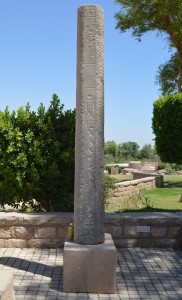 East side |
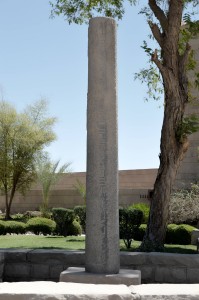 South side |
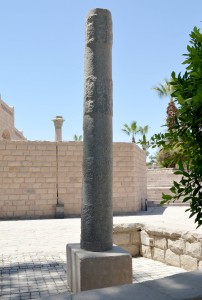 West side |
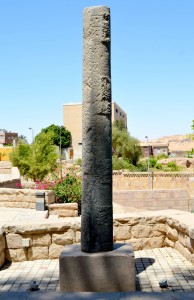 North side |
|||
April 29, 2016 by Hiroyuki Nagase (For high definition image, please click the picture) | ||||||
Copyright Hiroyuki Nagase nagase@obelisks.org and Shoji Okamoto okamoto@obelisks.org